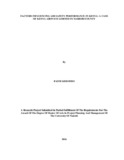| dc.description.abstract | The purpose of this study is to examine factors influencing air safety performance in Kenya.
The objectives of this study are: To assess how the implementation of air safety curriculum
influences airline safety performance, to establish how the capacity of instructors influences
airline safety performance, to evaluate how management support on air safety training
influences airline safety performance and to assess how re-current training influences airline
safety performance. The Literature review focused on all the above mentioned objectives.
The research project employed a survey design. This design was appropriate for this study
because it necessitated collection, organization and summarizing data from a sample for
conclusions. Descriptive statistics and inferential statistics were used to analyze the data.
Frequencies were used to analyze all the four sections of the questionnaire. Summary
measures of central tendency (mean) and dispersion (standard deviation) was calculated.
The study revealed that there was a positive significant relationship between implementation
of the air safety curriculum and air safety performance. The study further revealed that there
was a positive significant relationship between capacity of instructors and airline safety
performance. The study also revealed that there was a positive significant relationship
between air safety performance and management support for training. Finally the study
revealed there was a positive significant relationship between re-current training and airline
safety performance. The study recommends the need for Kenya Airways to enhance the
training curriculum content which is considered to be very important to organizations in the
airline industry as they guide the manner in which training is carried out. A well researched
training curriculum that seeks to incorporate research findings drawn from need assessment
improves professional skills that enhance airline staff to work more efficiently. The study
also recommends the need to ensure that training instructors are well equipped with requisite
skills so as to be able to effectively calibrate and standardize their own skills. The study
further recommends the need for the management to equip employees with suitable
resources, tasks as well as abilities to design, classify, employ and gauge their work, so that
they can be able to carry out necessary action in order to fully optimize their contributions to
the organization in a manner that is valuable to air safety performance. Finally the study
recommends the need for management to offer good leadership. This means therefore that
there is need to balance between effective leadership experiences, combined with valuable
management skills, which can enhance air safety performance | en_US |



